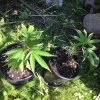I look forward to seeing how the supercropping goes. I thought about mainlining mine... but I'm trying to go for a low maintenance grow this year, so I'll abuse them in less time consuming ways.

I've got a pair of J1 photos I'm going to keep small (the only non-autos I have going this summer). I got the clones on the 8th when it was still cool and rainy, and since they were outside when I picked them up I didn't think much about hardening them. Two days later the sun came out all day, the high that day was only 70º so I didn't think twice about them... but they got pretty badly burned.
They've been recovering under some burlap in an area that only gets partial sun, but I'm pretty sure the late start and the burning will stunt them. I'll also keep them in smaller pots, possibly only 10 gallons to keep them smaller and allow me to finish them indoors if that seems like a good idea at the time.
View attachment 4153168 View attachment 4153170 View attachment 4153169









